Ag truckers get a 90-day ELD waiver
If you truck your plant material more than 150 air miles (or 172 road miles) from your greenhouse or nursery, you should be aware that you now face new Electronic Logging Device (ELD) rules that go into effect December 18. These devices automatically record your truck (and driver's) travel history, so drivers can’t fudge the log books and do more driving than legally allowed.
If you read the article “New Rules for the Road” by Matthew Castriotta of trucking company Reed TMS Logistics in GrowerTalks' November issue, you’ll know all about the new rule.
However, the Department of Transportation has granted a 90-day waiver for agricultural and livestock haulers, while they consider an exemption that would take into account the well-being of animals. This comes after seven livestock organizations petitioned DOT for a waiver and exemption. It sounds like the temporary waiver covers all of agriculture, not just live animal haulers.
However, it’s unlikely that plant haulers will get an exemption from the ELD rule, so get your electronic logging devices fired up!

The 150-mile (by air) ag exemption
There is one exemption for agriculture producers that I mentioned above. Former editor Debbie Hamrick, now with the North Carolina Farm Bureau, brought it up after reading Matthew’s article. She wrote to me:
“In omitting information about the 150-air-mile exemption for agriculture, Matthew overlooked an important way the rule accommodates ag producers, including greenhouse growers. Agriculture receives an exemption for the first 150 air miles (172 road miles) from the farm before the ELD begins to count time. At the 172 road-mile mark, the ELD time counts. Please note that the exemption is tied to hauling agricultural commodities during planting and harvest season, which may vary by state. Here in North Carolina it’s defined as 12:01 a.m. January 1 to December 31 midnight.”
Good point, Debbie! I asked Matthew if he could offer any clarification or insight about the ag exemptions. He replied thusly:
“Agricultural HOS (Hours of Service) exemptions have been around prior to the ELD Mandate. If your readership believes they qualify for exemption from HOS rules, I recommend they call the FMCSA (Federal Motor Carrier Safety Administration) to make sure they fully comply with the limitations of that exemption. If a driver goes over the 150 air-mile limitation, they will still need to have ELDs installed in their Commercial Motor Vehicle (definition can be found on FMCSA website) unless they have an old power unit (separate exemption). The rules may be a little unclear for some of your readership who might not deal with trucking as their primary business operation.
"The fines for not complying with the ELD Mandate and violating HOS rules are in the hundreds and thousands, and non-compliance fines and fees may pose a serious risk to your readers’ businesses if they get caught breaking the rules. With ELDs it will be easier to get caught breaking the HOS rules, especially next year when it will probably be an emphasis for enforcement.”
Matthew concluded with this advice:
“If I were a grower with trucks, I would call the FMCSA for verification of any exemptions my business may qualify to run under.”
That number would be (800) 832-5660.

MSU gets an LED install
We count on universities to test the new products coming into horticulture, and to that end, Michigan State University will be getting some serious practical experience with LED (light-emitting diode) lighting in 11 of the teaching greenhouses at the East Lansing campus. Philips Lighting is doing the installation, which will feature 264 of Philips toplighting modules with deep red/white/medium blue LEDs. The LED installation is one of the largest at any university in North America.
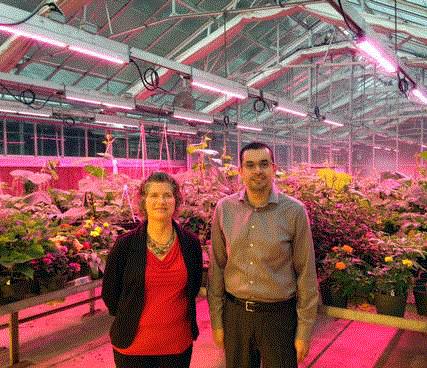
MSU uses their supplemental lighting for up to 16 hours a day between October and April, so just the decrease from 440 watts per fixture to 200 watts per LED will save a projected $15,000 in electricity.
Members of the Department of Horticulture, including Roberto Lopez, assistant professor, and Kristin Getter, academic specialist (pictured), have sought funding partnerships to revamp all aspects of the teaching greenhouses.
“We’re thankful to Philips, and we appreciate their collaboration in helping us create modern greenhouse teaching and outreach laboratories,” Kristin said. The greenhouses getting the LEDs are primarily used for teaching, as well as growing plant material for the on-campus horticultural trial gardens.
By the way, if you're curious, MSU’s Department of Horticulture currently has 123 students enrolled in the four-year major program, 28 students pursuing horticulture minors and 39 students in the two-year program. Don't know how that compares to previous years, but it's 190 future employees headed our way!

Painted poinsettias: I love writing about them!
I think the only person who likes talking about painted poinsettias more than I do is Andrew Lee of Fred C. Gloeckner Company, the folks that launched the painted poinsettia trend (or travesty, depending on your point of view) back in … when was it? 2004? 2005? … with their line of Fantasy Colors dyes and glitters. Andrew is a true ambassador of the product and concept.
Why do I like painted poinsettias? Because they spur conversations about poinsettias. I mean, put a bench of colorful painted poinsettias in your garden center and I guarantee you’ll get customers standing around them for 15 minutes at a time, talking about how much they love or hate them. When was the last time folks looked that closely at poinsettias? Maybe when Winter Rose was introduced?
So I suggest using paint and glitter as a conversation starter, knowing you’ll sell some of them—and for a healthy price premium, if you’re smart.
That’s what K&W Greenery of Janesville, Wisconsin, does. They’ve long been a fan of Fantasy Colors, and they use the product better than just about anyone else I’ve seen, making frame-worthy works of art. This old photo from my first visit there (2005!) remains one of my favorites:
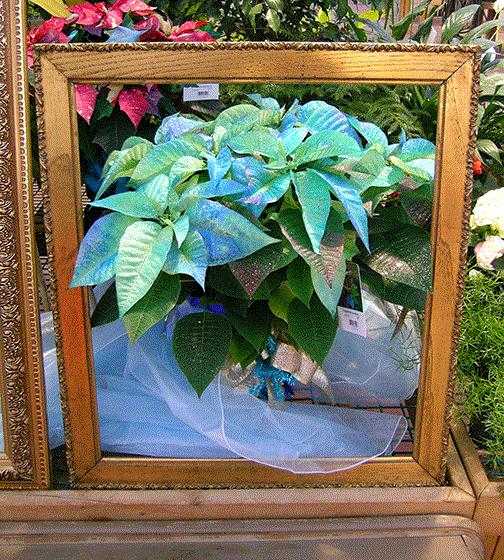
Co-owner Chris Williams is the only reader who replied to my call for images of painted poinsettias. Says Chris, “They are selling well again this year.”
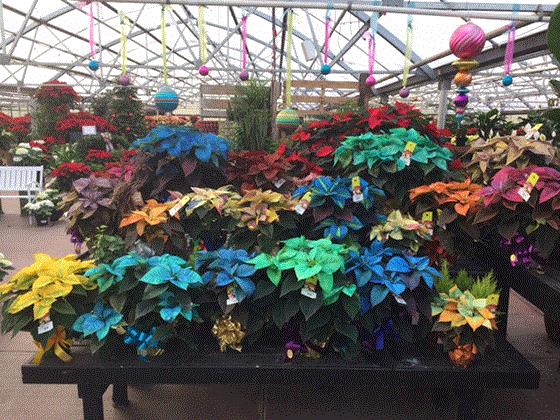
When Jen Zurko and I were at Heimos’ poinsettia trial a couple of weeks ago, we shot this photo of their crew spraying big batches of poinsettias. Granted, they do thousands of them in a few colors and styles, not the one-off art pieces I’m attracted to. But with sales of painted poinsettias up 18% over the last couple of years according to Amy Morris, Heimos is proof that they sell. (These are Marblestar with a mist of silver paint and a dusting of silver glitter.)


Pet plants might boost sales
Impressed by my report last week that Ball Hort’s Dr. Marvin Miller owns two houseplants that are close on to 40 years old? I was, too, but I shouldn’t be. I’ve got a beautiful ficus Spire that I brought home from Kraft Gardens in 1993 when I did a story on the new cultivar. He’ll be 25 this spring and absolutely loves his new corner of the Garden Room (previously, he’d spend the summer on the patio and the winter in the front foyer).
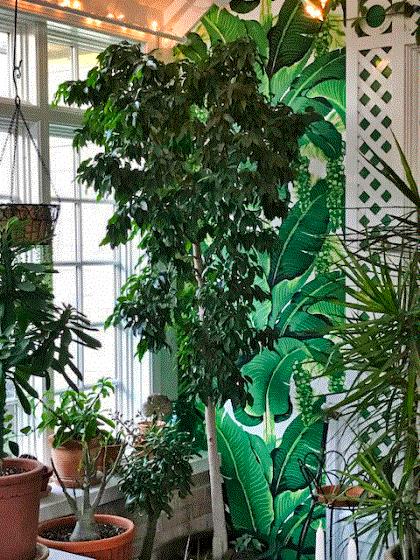
Reader Karen Brohl’s of Brohl’s Flower Garden in Michigan sent me this picture of her 31-year-old Yucca:
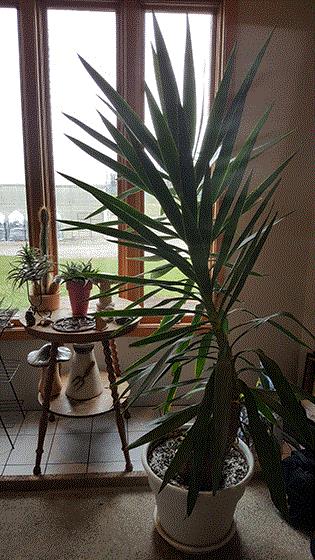
Impressive, Karen!
Any others of you have pet plants that are of a venerable age? If so, send me a NOTE and photo and brag on their longevity!
The topic of Marvin's 40-year-old plants came up yesterday in an editorial team meeting (possibly after the topic of heirloom turkeys for Thanksgiving, but I’m not sure), and I had a sudden idea: Maybe “pet plants” is another way to get folks interested in gardening.
Think about it: Most people have no idea that plants, when given the right spot and right care (which usually means minimal), can last for years, decades even, to where they become like a member of the family. It makes the $5 or $10 African violet or pothos seem a real bargain!
If you or one of your employees have an elderly pet plant, why not show it off to customers? Set it up in a prime spot in the garden center or nursery, with a spotlight and a sign. Maybe throw it a birthday party! You might even get it featured in a local newspaper—reporters are always looking for fun human-interest—or plant-interest—stories.

Spring Trials tour planned
Our friend Dr. Mark Bridgen of Cornell is once again organizing a bus tour of the California Spring Trials, slated for April 13-17, 2018. This will be Mark’s fifth tour (the previous being 2010, 2011, 2013 and 2015). He bills it as “an intense, educational and very entertaining way for growers and horticultural professionals to visit several of the key Spring Trials locations with fellow horticulturists.” Amen!
The beauty is, no planning! Mark does all the legwork of arranging stops, finding hotels and such. You just sit back and look at flowers all day! (Much like me, as Jen Zurko makes all our arrangements. I do drive the car, however … . )
Anyway, back to Mark’s tour: The cost ($690 for double room, $1050 for single) includes four nights hotel, bus transportation, lunches, shuttle service from the airports on the first day and an experienced guide. You handle your own airfare.
Here’s the tentative schedule*:
Saturday, April 14: Visit Proven Winners, Syngenta Flowers and Danziger
Sunday, April 15: Visit Sakata and Dümmen Orange
Monday, April 16: The big Ball Hort trials at PanAmerican Seed, and the even bigger GroLink trials, which feature about a dozen companies. The day wraps up with a trip down to Hollywood with a stop for a wine-tasting, time permitting.
Sounds like a great trip, and if I didn’t already have plans with Jen and Ellen, I might join you!
Interested? Contact Dr. Bridgen at mpb27@cornell.edu or at (631) 727-3595 if you have questions about details of the trip.
For online reservations, click HERE. For registration questions, call Denise at (203) 262-6260 or (800) 274-5801.
*Trip is subject to change and may be cancelled if minimum capacity is not met.

Costa’s Rimland joins AIPH board
I’m not sure when the last time was that the United States was represented on the board of the International Association of Horticultural Producers (AIPH), but we’ve got one now: Mike Rimland of Costa Farms in Homestead.
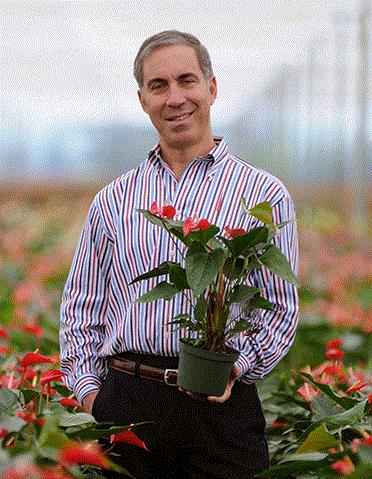
Mike, the director of R&D for Costa’s indoor plant division, was part of the Costa team that accepted AIPH’s “International Grower of the Year Award” in 2016.
Mike is taking over the seat of Bill Stensson from Sheridan Nurseries in Canada. He was nominated by AIPH member AmericanHort and had the support of the other member countries in the region.
A well-seasoned horticulture veteran, Mike is considered one of the world’s leading authorities on indoor plant varieties. He has 40 years of plant hunting, breeding and production experience and he spends a considerable amount of time traveling the world, talking to breeders and growers.
The other AIPH board members are:
Mr. Bernard Oosterom, Netherlands (President)
Mr. Tim Edwards, UK (Vice President and Chair of Ornamentals Production Committee)
Prof. Zhang Qixiang, China (Vice President)
Ms. Karen Tambayong, Indonesia (Chair of Green City Committee)
Mr. Kevin Chung, Chinese Taipei (Chair of Exhibitions Committee)
Mr. Osman Bagdatlioglu, Turkey
Ms. Kong Haiyan, China
Mr. Andras Treer, Hungary
Mr. Gijs Kok, Netherlands
What is AIPH? It is the association of the world’s horticulture associations. AIPH (which is the acronym for the official French name “Association Internationale des Producteurs de l’Horticulture”) was founded in 1948 in the aftermath of World War II to mend relations and rebuild bridges between Europe’s horticulturists. Today there are more than 50 associations around the world that belong, including AmericanHort, the Canadian Ornamental Horticulture Alliance, the Federation Interdisciplinaire de l’Horticulture Ornementale du Quebec, Canadian Nursery Landscape Association and Flowers Canada Growers Inc.
For more, visit www.aiph.org.

American to head IFOAM-Organics International
Peggy Miars, Executive Director and CEO of OMRI (the Organic Materials Review Institute), has been elected president of the IFOAM-Organics International World Board at their General Assembly November 12 in New Delhi, India.

IFOAM stands for “International Federation of Organic Agriculture Movements.” The name of the group, founded in 1972, is pretty self-explanatory: It’s much like the aforementioned AIPH, except for organic agriculture organizations.
Peggy has some solid organic street cred, including the Executive Director/CEO of OMRI since 2010, six years as Executive Director/CEO of California Certified Organic Farmers, three years as Consumer Marketing Manager for Earthbound Farm and two years as Marketing Director for Granary Market/Whole Foods in Monterey, California. She’s been on the IFOAM board since 2014.
Interestingly, she got her education (Bachelor of Business Administration, Marketing Major, General Business Minor) at Western Michigan University in Kalamazoo.
Finally I …
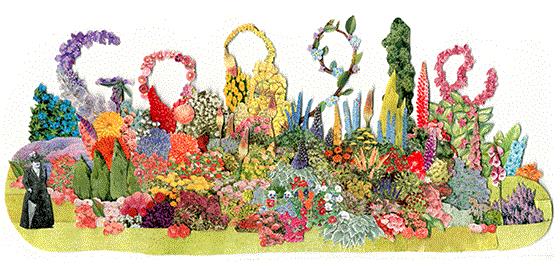 Did you catch the Google Doodle for Wednesday, November 29? It was this pretty garden scene, designed in honor of the 174th birthday of British garden designer Gertrude Jekyll (1843-1932). According to her website, she not only designed more than 400 gardens in the UK, Europe and America, she also had a nursery business and was a plant breeder. She was also a prolific writer, penning more than 1,000 magazine articles. (Although apparently she was a high-maintenance freelancer. One of her editors reportely said, "I would rather have clipped the wings of an archangel" than tamper with any text which she supplied to a publisher.)
Did you catch the Google Doodle for Wednesday, November 29? It was this pretty garden scene, designed in honor of the 174th birthday of British garden designer Gertrude Jekyll (1843-1932). According to her website, she not only designed more than 400 gardens in the UK, Europe and America, she also had a nursery business and was a plant breeder. She was also a prolific writer, penning more than 1,000 magazine articles. (Although apparently she was a high-maintenance freelancer. One of her editors reportely said, "I would rather have clipped the wings of an archangel" than tamper with any text which she supplied to a publisher.)
Finally II …
Where’s Chris this time?
Friday night I head out on the long trip to Melbourne, Australia, where I’ll be helping cover, in photo and video, the grand opening of Ball Australia’s new facility, which will take place during Ball Australia's Grower Trials—their version of Spring Trials. I’m even bringing Snoopy II for some aerial shots (I’ve checked, and I don’t think the drone rules are as strict in Australia as in Nicaragua. I mean, they already have boomerangs whizzing through the air, right?).
My first trip to Ball Australia was six years ago, in 2011, so I’ll see how things have changed, if at all, since then. I’ll catch up on the local market conditions and get out into some growers and retailers to look for trends and ideas. Watch for coverage in the next Acres Online.
See you next time!

Chris Beytes
Editor
GrowerTalks and Green Profit
This e-mail received by 22,421 loyal readers!
Thanks to my loyal sponsors, who help me reach the 22,421 readers of Acres Online in 66 countries! Want to be one (a sponsor, that is)? Give Paul Black a shout and he'll hook you up.